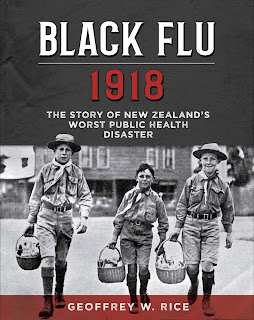The lessons of the 1918 influenza pandemic could help inform
planning for a future pandemic in New Zealand, according to historian Dr
Geoffrey Rice.
Dr Rice had New Zealand’s secondary school students in mind
as he worked on Black Flu 1918: The story of New Zealand’s
worst public health disaster, a condensed and updated version of his
2005 book Black November.
The pandemic was New Zealand’s worst public health disaster.
The whole country seemed to shut down for several weeks in November 1918.
Because the victims’ bodies turned black when they died, many believed it was
the plague.
“It’s a topic commonly covered in the New Zealand secondary
school curriculum. This edition is a slim version, with colour photos and
illustrations which will appeal greatly to students,” says Dr Rice.
“In writing for this audience the key was to be myself and
just enlighten them.”
“It remains, for instance, the worst disease since the Black
Death and it changed the end of the First World War. So many troops were affected
they couldn’t be sent on strategic offensives. If it weren’t for the flu, the
face of Europe following the war could have been very different.”
The book poses the question ‘Could it happen again?’ The
risk of another major influenza pandemic is even greater now, thanks to
international jet travel. However, global flu surveillance should give us
better warning, and we now have anti-viral drugs and antibiotics to deal with
the secondary pneumonia that was the real killer in 1918.
Dr Rice says that when planning for a future pandemic,
people needed to consider the resources they have and what systems are in place
to deal with another massive health crisis.
“If you know what has happened in the past, you can avoid
making mistakes in the future.”
Dr Rice’s original 1988 book Black November, which included graphs but no photos, was the first
national level study of the 1918 influenza pandemic based on individual death
certificates. For that work Dr Rice interviewed as many survivors as he could
find – about 150 people.
He says it was important to revise the book for a second
edition in 2005 because the academic and non-academic literature on the
influenza pandemic had expanded hugely since the 1990s. The second edition also
included numerous photos and a selection of the best interviews and letters
from survivors. The new publication, Black Flu 1918, features new colour illustrations, and includes work done by
Professor Nick Wilson on memorials to the epidemic, including Māori memorials.
“The registration of deaths of Māori is very incomplete and
it is likely that less than half were registered in some regions like Northland
and Waikato,” says Dr Rice, who will be giving a paper on the subject of Māori
death records in 1918, on the centennial of the pandemic, at an international
conference in Madrid in November.
Black Flu 1918: The story of New Zealand’s worst public health disaster
by Dr Geoffrey Rice published by Canterbury University Press, October
2017, RRP $29.99, ISBN: 978-1-927145-95-1

No comments:
Post a Comment